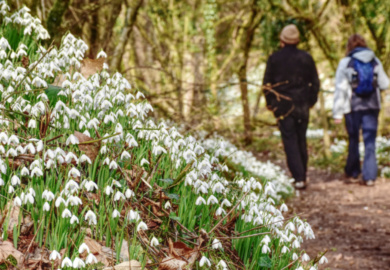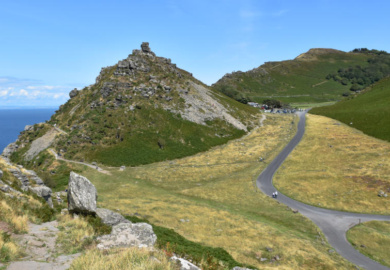There were three things we wanted to do in Bristol – find a Banksy; stand beside Archie Leach; and see the Clifton Suspension Bridge. Two of these we could tick off in the city centre, the other required a short journey. Google Maps told us it was only a forty-five-minute walk from Bristol City Centre to the Clifton Suspension Bridge. A doddle, we’d notch that up just walking around the shops. Plus, walking is by far the best way to get to know a city … or anywhere.

From Bristol Bridge upward
Approaching from the Temple Mead side, crossing Bristol Bridge felt like we were entering a more interesting part of the city centre. One of the theories about the origin of the city’s name is that it was once known as Brigg stow (or Brigstow, or even Brygstow – spelling was flexible back in ye olde day) which meant ‘meeting place by the bridge.’ Bristol Bridge, built in 1768 and the furthest upstream of Bristol’s bridges, marks the limit of navigation for any ship or vessel on the river. So, it seemed like the ideal point for setting off on foot.
There’s a tasty distraction almost immediately. St Nicholas Market has been a working market since 1743 and is now a mix of bric-à-brac, craft, and food stalls which tempt with street food from around the world, ranging from pies and pitta to jerk pork. As much of it is covered, it’s great for eating al fresco whatever the weather.

The next point of interest heading west are the Christmas Steps, linking Colston Avenue with Colston Street via a narrow alley that’s easy to overlook. There’s something Harry Potter-ish about the crooked stairs that climb past quirky shops and galleries. Appropriately, there was a fashion shoot taking place on them when we were there. Why they are called the Christmas Steps nobody can say for sure. One theory is that the connecting Christmas Street was so-called because of the Chapel of the Three Kings of Cologne (named after the Three Wise Men) near the top of the steps. Another is they were named after a local merchant. And yet another that it was in some way linked to a previous name, Knyfsmythe Street. What is certain is the Christmas Steps were called Queen Street until 1775.
A learned area
Continuing west and up, there’s little of interest apart from shops and tempting little cafes; this is a route where finding somewhere to pause for a refreshment isn’t a problem. As this is university territory, there are takeaways galore. Catching the eye directly ahead is the Neo-Gothic Wills Memorial Building Tower which, despite looking older, was completed in 1925. It houses Bristol University’s School of Law and the School of Earth Sciences but the main attraction for non-academics is there’s a great view from the top of the sixty-eight-metre-high tower (£5 admission). There was a campaign to change the tower’s name a few years back as it is named after the Bristol University’s first chancellor, Henry Overton Wills III, whose family made their fortune from tobacco on the back of the slave trade.
Beyond the tower is the Bristol Museum & Art Gallery which is free to enter and has nineteen galleries over three floors, covering art, architecture, geology, and natural history.

This part of the route bustles with students. While there are numerous places to grab something to eat, they tend to be mainly fast-food joints, of which too many are international brands.
The scene calms down once you turn off Queens Road to do an up and over along Richmond Hill.
To Clifton and the Bridge
The route we followed meandered through a pleasant and leafy residential area before crossing Victoria Square, where W.G. Grace lived. It may or may not have been home to what was known as the ‘birdcage walk,’ a place where, one account claims, fine women used to parade carrying small cages with birds. Sounds a bit iffy, so we’ll have to research more.

Victoria Square leads to a lovely little arch which acts as a charming portal to the upmarket and boutique-y suburb of Clifton. On the other side of the arch lies The Clifton Arcade, an attractive Victorian shopping centre. The official tourist website promises ‘some of the most unusual shopping in Bristol’ and ‘…there really is something for everyone.’ Truth is, we were disappointed with the shops in the arcade, but not with Clifton itself. It is delightful, the sort of place where you want to spend more time, wandering from bakers to bars and cafes to craft shops. These lead all the way to the edge of Clifton Downs, the Clifton Observatory (which has a Camera Obscura and a tunnel leading to the Giant’s Cave) and the objective of the walk, the Clifton Suspension Bridge.
Designed by Isambard Kingdom Brunel, the Clifton Suspension Bridge (built between 1831 and 1864) is one of those iconic landmarks that defines a destination. We’ve wanted to visit since first seeing it on TV. Images of it with hot air balloons drifting across the sky behind, lured us in even more. It turns up all over the place, even in The Great Pottery Throw Down. It is instantly recognisable, an iron masterpiece of engineering above a city that somehow manages to remain mostly hidden.

Seeing it with our own eyes did not disappoint – from up close, from a viewing point just below, and from the cliffs behind it. Even after the day turned grey, it was as impressive as hoped.
Once our appetite for viewing the bridge from different angles was sated, we followed the same route back to the centre, detouring down the A4108 instead of staying on Park Row. The reason? Almost at the bottom, where the A4108 meets College Green is a classic Banksy work of street art, Well Hung Lover.

The satisfying pay-off for pounding the streets for an hour and a half or so was two Bristol ‘must sees’ and a whole lot more to boot. Those make it a pretty appealing city route.

